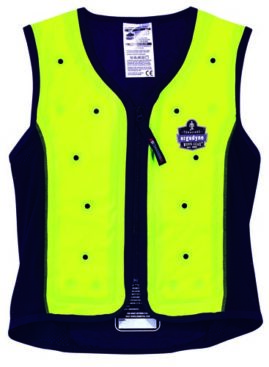Mitigating heat stress
What considerations need to be made when it comes to mitigating heat stress in outdoor vs. indoor work?

Responding is Alsie Nelson, senior product manager, Ergodyne, St Paul, MN.
Every summer, the stats add up. From 1992 to 2017, heat killed 815 workers in the United States and injured some 66,000 more (according to BLS). Although a lot of focus is on workers toiling outdoors in the summer sun (construction, landscaping, etc.), those working indoors (warehouse, foundries, etc.) are also very much susceptible to heat stress.
Heat stress occurs when the body’s ability to control its internal temperature begins to fail. When body temps rise above 99.7° F (37.6° C), the body begins to sweat profusely. If the body isn’t allowed to cool and its temperature reaches 104° F (40° C), severe heat-related illness can occur. Symptoms of heat stress include headache, excessive sweating, dizziness, heat cramps, confusion and more.
The good news is, whether working indoors or out, heat illness is 100% preventable with a few relatively minor and simple adjustments – including deploying the right cooling gear for the job at hand.
Evaporative vs. phase change technology
Cooling gear is a great way to supplement the guidelines set forth by OSHA’s “Water. Rest. Shade.” initiative, with evaporative cooling vests becoming more and more popular. They’re a simple, effective and relatively inexpensive approach that can be used in outdoor and indoor environments, but work best outdoors in drier, low-to-moderately humid conditions with sufficient airflow.
Much like how sweat cools the body, evaporative cooling solutions draw heat from workers’ bodies, using an external source of water. They can provide an enhanced cooling effect, even for workers still acclimatizing to new tasks or to a change in environment. And they can help experienced workers keep their cool. Although any damp rag could provide some relief, controlled evaporation – with fabrics that hold moisture for extended periods of time and products that are comfortable to wear – will provide significantly more effective results for more productive workers.
Unlike evaporative cooling technology, airflow is not required for phase change cooling, making it a prime choice for high-heat indoor settings such as foundries, glass manufacturing, and paper and pulp. Phase change cooling vests use a cooling charge pack that works to pull heat away from the body (heat energy always moves from a warmer place to a cooler place). These packs contain liquids such as non-toxic phase change material that solidify typically between 55° F (13° C) and 64° F (18° C).
But unlike conventional ice or gel freezer packs, phase change packs aren’t frosty to the touch, so they’ll remain comfortable against the body and stay cool a lot longer than ice. As the phase change cooling pack absorbs heat, it begins to change from a solid to a liquid. The cooling effect can last anywhere from 90 minutes to four hours, depending on the solution.
Editor's note: This article represents the independent views of the author and should not be construed as a National Safety Council endorsement.
Post a comment to this article
Safety+Health welcomes comments that promote respectful dialogue. Please stay on topic. Comments that contain personal attacks, profanity or abusive language – or those aggressively promoting products or services – will be removed. We reserve the right to determine which comments violate our comment policy. (Anonymous comments are welcome; merely skip the “name” field in the comment box. An email address is required but will not be included with your comment.)

